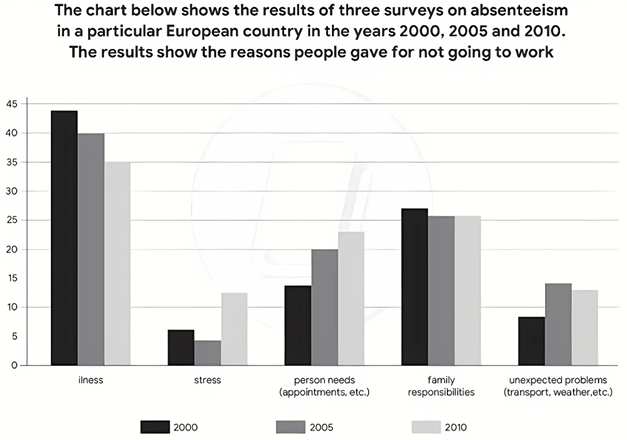5+ The chart below shows the results of three surveys on absenteeism in a particular European
The chart below shows the results of three surveys on absenteeism in a particular European country in the years 2000, 2005 and 2010. The results show the reasons people gave for not going to work. Summarise the information by selecting and reporting the main features, and make comparisons where relevant. Write at least 150 words hay nhất giúp bạn có thêm tài liệu tham khảo để viết bài luận bằng Tiếng Anh hay hơn.
- The chart below shows the results of three surveys on absenteeism in a particular European (mẫu 1)
- The chart below shows the results of three surveys on absenteeism in a particular European (mẫu 2)
- The chart below shows the results of three surveys on absenteeism in a particular European (mẫu 3)
- The chart below shows the results of three surveys on absenteeism in a particular European (mẫu 4)
- The chart below shows the results of three surveys on absenteeism in a particular European (mẫu 5)
5+ The chart below shows the results of three surveys on absenteeism in a particular European
Đề bài: The chart below shows the results of three surveys on absenteeism in a particular European country in the years 2000, 2005 and 2010. The results show the reasons people gave for not going to work. Summarise the information by selecting and reporting the main features, and make comparisons where relevant. Write at least 150 words
The chart below shows the results of three surveys on absenteeism in a particular European - mẫu 1
The bar chart illustrates absenteeism trends in a European nation from 2000 to 2010.
In general, illness was consistently the primary reason for work absence, while stress was the least cited factor. Absenteeism due to stress, personal needs, and unforeseen issues increased, whereas cases related to illnesses and family responsibilities declined.
In 2000, a massive 45% attributed their absence to illness, which decreased steadily to 35% by 2010. Similarly, family responsibilities showed a slight dip from 27% in 2000 to just below 25% in 2005 and remained stable thereafter.
Absenteeism due to personal needs, in contrast, saw a steady rise, from roughly 13% to 23%, always ranking third. Unexpected problems causing absence exhibited a rise from 8% in 2000 to just below 15% in the commencing five years, followed by a minor drop in the five ensuing years. Conversely, stress-related absenteeism began at slightly above 5% and after a trivial drop of 3% in 2005, rebounded to around 12% by 2010.
The chart below shows the results of three surveys on absenteeism in a particular European - mẫu 2
The bar chart illustrates how absenteeism rates, categorized into five different reasons, changed in a country in Europe in three separate years, namely 2000, 2005 and 2010.
Overall, while the percentages of respondents citing illness and family duties as reasons for being absent from work decreased, those citing stress, personal needs, and unexpected problems showed upward trends. Additionally, illness was consistently the major reason why people did not go to work, whereas the opposite was true in the case of stress.
In the first year, the proportion of individuals ascribing their work absence to sickness stood at nearly 45%. Despite seeing a steady decline to 35% a decade later, this reason remained the most prevalent throughout. Family obligations followed a similar trend, starting at approximately 27% before leveling off at just above 25% from 2005 to 2010.
When asked why they were not at work, initially, around 14% of people surveyed attributed it to personal needs such as appointments and so on, after which it had risen by about one-tenth by 2010. Stress, meanwhile, saw a lower growth rate, beginning at roughly 6% and ending at around 12% in the final year. An increase was also witnessed in the figure for unexpected issues (transport, weather and suchlike), growing from around 8% to peak at close to 15% after 5 years before falling minimally in 2010.
The chart below shows the results of three surveys on absenteeism in a particular European - mẫu 3
The bar chart illustrates how absenteeism rates, categorized into five different reasons, changed in a European country in three distinct years: 2000, 2005, and 2010.
Overall, while the percentage of workers being absent due to illness and family obligations was on a downward trend, reasons like stress, personal needs, and unexpected problems witnessed an opposite trend. Notably, illness remains the primary reason behind work absences whereas the opposite was true in the case of stress.
In the year 2000, nearly 45% of respondents attributed their absence to sickness. Although experiencing a steady decline, reaching 35% ten years later, this reason retained its dominance. Family obligations followed a similar pattern, commencing at roughly 27% before stabilizing just above 25% between 2005 and 2010.
Approximately 14% of surveyed individuals cited personal needs, such as appointments, as the reason for missing work. This figure escalated by roughly 10% by 2010. Stress, on the other hand, displayed a more moderate growth rate, starting at around 6% and ending at nearly 12% in the final year. Unexpected issues, encompassing transportation, weather, and similar occurrences, also witnessed a rise, increasing from approximately 8% to a peak of close to 15% after five years before experiencing a slight drop in 2010.
The chart below shows the results of three surveys on absenteeism in a particular European - mẫu 4
The bar chart gives information about the percentage of people who were absent from work because of five reasons in an unspecified nation in Europe over the course of 10 years from 2000 to 2010.
Overall, while there were increases in absenteeism rate due to stress, personal needs and unexpected problems, downward trends can be seen in issues related to illnesses and family responsibilities. Despite that, illness was consistently the leading factor responsible for absence from work, whereas stress remained the least stated reason, according to survey respondents.
In 2000, slightly less than 45% of surveyed individuals attributed their absence from work to illness-related issues, and despite recording a progressive drop from this point on, its figure still retained the top position, ending the period at 35%. Similar changes, but to a lesser degree, were observed in workers having to fulfill family responsibilities, whose proportion declined from approximately 27% in 2000 to almost 25% five years later, followed by another five-year period of stability until 2010.
Personal needs, such as appointments, was the only category which saw a steady growth in almost every 5-year-period, rising by nearly 10%, from roughly 13% to 23%. Meanwhile, the percentage of respondents whose unanticipated problems prevented them from going to work, which started at roughly 8% in 2000, experienced a rise to marginally under 15%, and then generally stayed at this level until the final year.
Finally, being absent from work because of suffering from stress was constantly mentioned in relatively small numbers, beginning at slightly above 5%. Although its data declined slightly, hitting a low of around 4% in 2005, it subsequently rose sharply and by 2010, had reached around 12%.
The chart below shows the results of three surveys on absenteeism in a particular European - mẫu 5
The chart illustrates why workers in a European country took several days off from work in three particular years, namely 2000, 2005 and 2010.
Generally, /In general, /Overall, there was an increase in the percentages of employees being out of the office due to mental issues, personal problems and unforeseeable incidents, while the figures for physical unwellness and family duties witnessed an opposite trend. In addition, physical condition was the most common excuse for not being present at work among the reasons stated whereas mental health was the least.
About 44% of the workers surveyed being off work because of sickness in 2000, with/followed by a gradual decline to 35% in 2010. An opposite trend can be seen in the figure for those who were absent from work owing to personal requirements, which was about 14% in 2000 and grew consistently to 23% at the end of the period.
The proportion of individuals reporting family-related duties as a reason for their absence started at around 27% then dropped to 25% 5 years later and remained unchanged in the last year. Conversely, the figures for feeling stressed and unexpected adversities such as transport or weather experienced an overall growth over the period but with several fluctuations, which were approximately 6%, 4% and 13% for the former and 8%, 4% and 13% for the latter in the respective years studied.
Xem thêm các bài luận Tiếng Anh hay khác:
Đã có app VietJack trên điện thoại, giải bài tập SGK, SBT Soạn văn, Văn mẫu, Thi online, Bài giảng....miễn phí. Tải ngay ứng dụng trên Android và iOS.
Theo dõi chúng tôi miễn phí trên mạng xã hội facebook và youtube:Nếu thấy hay, hãy động viên và chia sẻ nhé! Các bình luận không phù hợp với nội quy bình luận trang web sẽ bị cấm bình luận vĩnh viễn.
- Đề thi lớp 1 (các môn học)
- Đề thi lớp 2 (các môn học)
- Đề thi lớp 3 (các môn học)
- Đề thi lớp 4 (các môn học)
- Đề thi lớp 5 (các môn học)
- Đề thi lớp 6 (các môn học)
- Đề thi lớp 7 (các môn học)
- Đề thi lớp 8 (các môn học)
- Đề thi lớp 9 (các môn học)
- Đề thi lớp 10 (các môn học)
- Đề thi lớp 11 (các môn học)
- Đề thi lớp 12 (các môn học)
- Giáo án lớp 1 (các môn học)
- Giáo án lớp 2 (các môn học)
- Giáo án lớp 3 (các môn học)
- Giáo án lớp 4 (các môn học)
- Giáo án lớp 5 (các môn học)
- Giáo án lớp 6 (các môn học)
- Giáo án lớp 7 (các môn học)
- Giáo án lớp 8 (các môn học)
- Giáo án lớp 9 (các môn học)
- Giáo án lớp 10 (các môn học)
- Giáo án lớp 11 (các môn học)
- Giáo án lớp 12 (các môn học)






 Giải bài tập SGK & SBT
Giải bài tập SGK & SBT
 Tài liệu giáo viên
Tài liệu giáo viên
 Sách
Sách
 Khóa học
Khóa học
 Thi online
Thi online
 Hỏi đáp
Hỏi đáp

